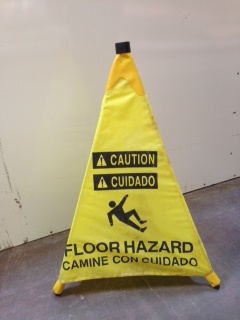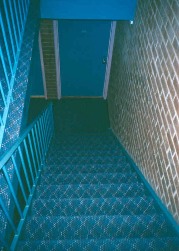Editor’s note: September is National Fall Prevention Month. The VisionAware peer advisors felt it important to bring to our readers the risk factors as well as what you can do to prevent falls. VisionAware has many resources to help you and many of these are included in this post.
Being Pro-Active
My vision loss has caused me to fall many times in the past. As I get older this concerns me because I realize the potential for serious injuries. So I decided to attend a workshop on Fall Prevention. I would like to share the highlights of what I learned since this is National Fall Prevention Month.

Falls Are Not a “Normal” Part of the Aging Process
Many people have a fear of falling as they age, especially if they are losing vision. In fact, falls are common among adults aged 65 and older with one out of three falling each year. Falls are a serious threat to your health and well-being and can result in injuries such as fractures, head trauma and even death. A fall can land you in the hospital or a long term care facility at great cost, threatening your independence. But falls are not a “normal” part of the aging process. They are predictable and preventable.
What Is a Fall?
A fall is any event when a person inadvertently comes to rest at a lower level, against a supporting surface, or on the ground. It happens when there is an unexpected change of position or loss of balance.”(Shumway-Cook 2012). Here are three questions to consider:
- Have you fallen in the past year?
- Do you feel unsteady when standing or walking?
- Do you worry about falling?
According to the Centers for Disease Control and Prevention (CDC) and their STEADI program, answering “YES” to any of these questions means you are at increased risk for falls.
What Are the Risk Factors for Falling?
Research shows there are many interacting factors which create increased risks for a fall. There are personal risk factors including:
- Difficulty with walking or balance
- Muscle weakness
- Foot problems
- Heart rate or rhythm problems
- A history of falls and/or a fear of falling
- Taking multiple medications (4 or more)
- Dizziness
- Depression
- Vision problems (cataracts, macular degeneration, wearing bifocals)
- Health conditions such as arthritis, stroke and diabetes

Environmental Conditions Contribute to Increased Fall Risk
Most falls happen due to home hazards such as:
- Stairs, no hand-rails
- Clutter
- Poor lighting
- Wet surfaces
- Cords
- Loose rugs and carpets
- Hurrying and rushing
- Uneven pathways
What Can You Do to Protect Yourself?

The fear of falling can diminish your ability to live an active life. It can lead to less mobility, isolation, and physical decline. There are actions you can take to alleviate this fear of falling and prevent falls. Make a plan to practice fall prevention and protect your independence. Here are some steps to take:
- Begin by talking to your healthcare provider. If they do not ask about your fall history, bring the subject up yourself. If you have had a fall or are afraid of falling, tell your healthcare provider. He/she can order a physical therapy and/or an occupational therapy evaluation to assess your strength, balance and home safety issues if needed. These professionals can design a training program and suggest changes to help reduce your fall risks. You may have to ask for these evaluations and most insurance plans cover these services.
- Review your medications with your healthcare providers. Know why you are taking each drug and the correct doses. Be aware of common side effects like drowsiness or dizziness. Ask to be prescribed the lowest dose possible and discuss whether any medications can be discontinued. Take your medicines as prescribed and report any side effects. Check with your provider before using herbal and over-the- counter products.
- Engage in healthy movement. Regular exercise improves muscle strength, balance, coordination and flexibility. Strong core and leg muscles have an “anti-gravity” effect and protect us against falls. Activities like walking, water classes, tai-chi, pilates and yoga improve your overall condition and go a long way to prevent falls. If you have other medical conditions that limit your ability to participate in such activities, a physical therapist can help create a custom exercise program aimed at improving your balance, strength, and gait. Ask your healthcare provider for a referral to physical therapy.
- Wear sensible shoes. Evaluate your footwear for safety. High heels, loose slippers, slide-in styles, and slippery soled shoes can make you stumble and fall. Do not go bare foot or walk in stocking feet. Choose properly fitting, supportive and non-skid shoes to reduce the risk of falls.
- Have your vision and hearing checked. Changes in vision and hearing can affect your balance and cause falls. Discuss with your healthcare team any conditions you have that affect these senses.
- Consult with a vision rehabilitation therapist or audiologist as needed to learn strategies to keep you safe.
- Make modifications in your home environment to reduce fall hazards. There are many simple changes that can be made to improve your independence and safety. Do a room-to-room assessment of your living space. Learn ways to reduce clutter, maximize lighting and contrast, make repairs and reorganize. Check out VisionAware’s home modification section for suggestions and try our home survey check list. For significant needs, consider getting a home assessment by an occupational therapist or vision rehabilitation therapist. Also, take a look at our fall prevention videos
- Light up your home. Aging and low vision call for increased lighting. Add additional lighting in hallways, stairways and outdoor walkways. Use the highest safe wattage in fixtures. Place nightlights in the bedroom, hallways and bathroom. Learn more about lighting in the home
- Use a mobility cane. If you are blind or have low vision and do not use a cane, consider orientation and mobility instruction. For more information on the importance of the cane in preventing falls, be sure to read Low Vision and the White Cane, a Tool for Fall Prevention
- Sign up for a community program on fall prevention. There are many resources to help you prevent falls. Involve family members in a conversation and brainstorm which strategies fit your needs.
- Contact your local hospital or senior center to ask if they offer classes. Some programs are offered through the Area Agencies on Aging in each state. “Stepping On” and “A Matter of Balance” are two national evidence-based programs for older adults.
It is largely up to you to prevent a debilitating fall. Take the first steps toward eliminating the fear of falling so you can live safely and confidently. The saying “An ounce of prevention is worth a pound of cure” by Ben Franklin has never been more true than when referring to a fall.